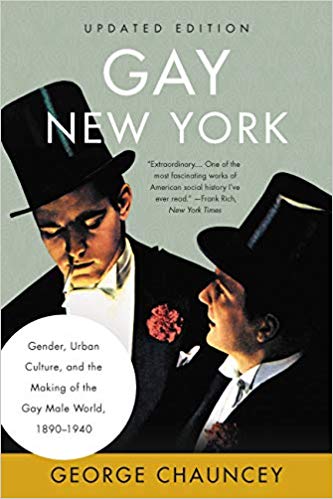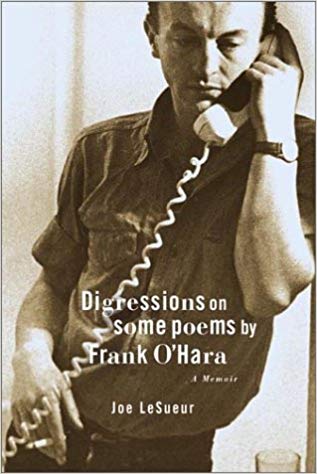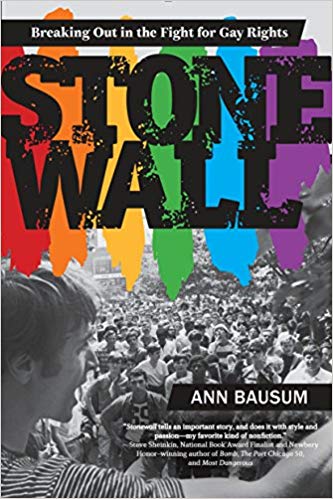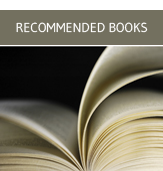Books for LGBTQ Pride Month: Gay Life and History in New York City
June is LGBTQ Pride Month, and 2019 marks the 50th anniversary of the pivotal Stonewall uprising in Greenwich Village. To celebrate, staff members recommend favorite books in our collection—new and old—on gay culture, life, and history in New York City. A list of further reading follows.
Gay New York: Gender Urban Culture, and the Making of the Gay Male World 1890 – 1940 | George Chauncey
Published on the occasion of the 25th anniversary of the Stonewall Riots, George Chauncey’s Gay New York reveals that urban gay life prior to 1969 wasn’t always hiding in the closet. Rather, Chauncey shows us that there was a vibrant and visible gay culture in New York City until the 1930s, when changing social mores pushed the gay world underground. He takes us to places where gay life flourished in the early 20th century—cafeterias, bars, and bathhouses—to rent parties in Harlem, and drag balls in Greenwich Village attended by thousands and covered in the press. At the time of its publication, reviews of Chauncey’s book called it “brilliant” and “monumental” and it remains so. It is also a fun and thrilling read that will change your mind about the city you love and what it was like a century ago. —Patrick Rayner, Acquisitions Assistant/Circulation Assistant
When Brooklyn was Queer | Hugh Ryan
Inclusivity is the name of the game where I’m concerned when it comes to writing about queer history, and Hugh Ryan delivers over and over again. Tracing Brooklyn’s queer culture from the era of Walt Whitman up to Robert Moses’ NYC, Ryan makes sure to incorporate stories from a range of people in the LGBTQ spectrum, from all walks of life, giving equal weight to stories both romantic and tragic. This is a history of queer people and queer spaces; many from both categories have been forgotten to time, until now. Ryan relays these histories with compassion and insightfulness, and brings to light important figures in queer history who should be celebrated. —Barbara Bieck, Special Collections Librarian
Angels in America: A Gay Fantasia on National Themes | Tony Kushner & The World Only Spins Forward: The Ascent of Angels in America | Isaac Butler and Dan Kois
By the time I saw a production of Tony Kushner’s game-changing epic, many of its phrases—poignant, political, perfect—had long entered my vocabulary. My then-boyfriend, pitying me for being too young for the original run, bought me the published play and with it a key to understanding the century of my birth. Kushner gives us not only an unforgettable portrait of a community and city in battle against AIDS, corruption, bad religion, and the closet, but also a dazzling cultural and counter-cultural collage, from the Army-McCarthy hearings to drag. Plus it’s so subversively funny that you want to proclaim lines aloud in the subway in pure campy celebration. Butler and Kois’ monumental oral history breaks the text apart and restitches it with new insights from the mouths of the playwright, creative teams, and actors from the first gleam in 1987 to the wonderful 2018 London/Broadway revival—proving that this profoundly historical play is now itself part of America’s history. —Sara Holliday, Head of Events
Digressions on Some Poems by Frank O’Hara | Joe LeSueur
In this memoir, Joe LeSueur describes his life among the New York School poets and artists. LeSueur met O’Hara at party in 1955 and they became fast friends. Both were young, gay, and prone to bad behavior. For the next ten years they lived together, mostly as friends but sometimes as lovers, coinciding with the most productive period of O’Hara’s life. The book is electric, bouncing from high-minded to lowbrow as easily as LeSueur and O’Hara did. It’s populated with painters and pickups, the famous and the long forgotten, and it features quite a collection of booze-soaked antics. At the center of it all is O’Hara’s poetry, still as fresh and irreverent as it was when he wrote it. It’s a wonderful snapshot of the kind of gay life possible in New York pre-Stonewall for those courageous enough to seek it. —Patrick Rayner, Acquisitions Assistant/Circulation Assistant
I Must be Living Twice: New and Selected Poems, 1975-2014 | Eileen Myles
Eileen Myles is queer. At a recent Poetry Project reading at St. Marks church they scoffed at scholars’ obsession with exploring the details of the intimate lives of poets, saying that no one will have to dig deep in their past to discover their sexuality, there are notebooks upon notebooks, poems upon poems, stating explicitly that they are a lesbian. This frankness is often highlighted in their most recent poetry collection, I Must Be Living Twice. Spanning ten books and four decades, this selected volume solidifies their reputation as an underground star and modern force in contemporary poetry. The poems, featuring everything from autumn in New York to the quiet euphoria of falling in love, are deceptively simple and capture poignant honesty in casually humorous lines. These fast-moving city life poems serve as a fantastic introduction to this cult icon. —Morgan Boyle, Assistant Children's & Young Adult Librarian
Autobiography of a Family Photo | Jacqueline Woodson
In my opinion, every word of Jacqueline Woodson’s Autobiography of a Family Photo is chosen so carefully and artfully that the result is a perfect book. Set in the late ‘60s – early ‘70s, Woodson tells the story of a young girl in Brooklyn who “walks like [her] father” and is told over and over that she is “too skinny, too dark, too angry.” Through a series of vignettes that jump around in time, she sees her oldest brother, who likes to dress up in their mother’s high heels, get shipped off to Vietnam; she listens through the bedroom wall with her siblings to their parents fighting, her baby brother peeling paint chips off the wall to stuff into his mouth; her sister runs off to join a commune; her mother tells her she “looks like a dyke” when she walks with her hands stuffed into her pockets; she falls in love with her best friends, and then watches them get boyfriends and have babies. Though the narrator is gay, she never gets to outright say so, an aspect that only Woodson could treat so subtly, and with such heart. This book made me cry. I can’t wait to read it again! —Katie Fricas, Events Assistant
Queer Street: Rise and Fall of an American Culture, 1947-1985 | James McCourt
A very wise friend told me that among the many tragedies that accompanied AIDS was the loss of a generation of gay storytellers to bring people of my generation up to speed on gay culture. Luckily, some of the remaining voices have risen to the task, and foremost among them is James McCourt. His book Queer Street is a scrapbook comprised of bits of memoir, history, gossip, exaggeration, lists, fiction, and silliness. This pageant of gay life is peopled with camp icons like Bette Davis and Tallulah Bankhead, writers like Tennessee Williams and James Baldwin, and objects of desire like Marlon Brando and Montgomery Clift. At turns hilarious and heartbreaking, Queer Street is a truly unique account of gay New York. —Patrick Rayner, Acquisitions Assistant/Circulation Assistant
Stone Butch Blues | Leslie Feinberg
“History take note: I did not stand alone!” This is the final line in the acknowledgements in the first pages of Stone Butch Blues. This book has a specific place in my heart, and many of those of the LGBTQ community. Leslie Feinberg wrote Stone Butch Blues in 1993, providing insight into the lives of queer people living in Buffalo and New York City before the 1969 Stonewall Riot. Before Stonewall, tensions were high with social and political policing as a constant threat. Yet, the queer community continued together to forge meaningful lives, celebrate the parts of themselves that were considered taboo, and fight for their rights. It is a lasting testament to the Queer Revolution. —Ashley-Luisa Santangelo, Bibliographic Assistant
Times Square Red, Times Square Blue | Samuel R. Delany
Samuel R. Delany’s Times Square Red, Times Square Blue just celebrated its 20th anniversary this past April. Most known for his imaginative science fiction, Delany burst into the nearly all-white sci-fi world in the 1960’s. With fellow author Octavia Butler, Delany helped establish a foundation for today’s Afro-futurists authors. The central thesis of Time Square Red, Time Square Blue is that in our current conditions under capitalism, life is made more pleasurable when people have regular and spontaneous interclass contact. Delany develops this theory by looking at the old Time Square of the 1960s-1990s and the blooming sexual cultures of the time. As a frequent visitor of sex theatres and gay bars, Delany shows how people gained pleasure and access through interclass contact in pro-sex establishments. More than a love letter to a begone gay cruising ground, Delany challenges the homophobic gentrification that shuttered the sex establishments and turned Time Square into a Disneyland tourist trap. —lae sway, Circulation Assistant
How to Survive a Plague | David France
Exhaustively researched and elegantly told, How to Survive a Plague by David France chronicles the small group of men and women who fought for answers to the myriad crises caused by AIDS in the 1980s. They formed ACT UP at the Lesbian & Gay Community Services Center on West 13th Street to react to the horrors AIDS wrought and counter the cold and indifferent response they received from politicians and medical professionals. Many of the men featured here are dying as they fight the government, the pharmaceutical industry, not to mention the prevailing opinion that people with AIDS were only getting what they deserved. This is story of a triumph over impossible odds by people who decided to fight for their lives. It is a companion to France’s acclaimed documentary which shares the book’s title, but takes advantage of its format to tell a more nuanced and detailed history than the movie was able to. Though the subject matter is difficult, the book is powerful beyond measure and unlikely to be equaled as a history of the period. —Patrick Rayner, Acquisitions Assistant/Circulation Assistant
Close to the Knives: A Memoir of Disintegration | David Wojnarowicz
This is the unflinching, honest, powerful memoir of New York artist David Wojnarowicz, who recently had a retrospective at the Whitney. [The Library owns the catalog of that exhibition, History Keeps Me Awake at Night, as well as hisThe Waterfront Journals.] The autobiographical sketches in Close to the Knives are set during the beginnings of the AIDS crisis in New York. Wojnarowicz passed away due to AIDS complications in 1992. —Ashley-Luisa Santangelo, Bibliographic Assistant
Children’s & Young Adult Books
Stonewall: Breaking Out in the Fight for Gay Rights | Ann Bausum (ebook)
With a poetic prologue Ann Bausum leads readers on a tour of the West Village in 1969, ending in front of the Stonewall Inn, where “history walks through that door.” Throughout the rest of the brief, comprehensive, and compelling Stonewall: Breaking Out in the Fight for Gay Rights, Bausum details how LGTBQ New Yorkers lived—often in fear and mostly in the closet—in the years leading up to Stonewall riots, the events that spurred the raid and subsequent riots, life and death during the AIDS epidemic, and the decades of widespread activism and pride that have  followed that July evening in 1969. Though originally published in May 2015, the Library’s ebook edition contains a lyrical epilogue both acknowledging the Supreme Court’s June 2015 marriage equality decision and detailing the work that lies ahead in the fight for LGBTQ equality. —Randi Levy, Head of the Children’s Library
followed that July evening in 1969. Though originally published in May 2015, the Library’s ebook edition contains a lyrical epilogue both acknowledging the Supreme Court’s June 2015 marriage equality decision and detailing the work that lies ahead in the fight for LGBTQ equality. —Randi Levy, Head of the Children’s Library
What If It’s Us | Becky Albertalli & Adam Silvera (also available as an ebook)
Arthur, an enthusiastic and recently out teen from Georgia, comes to NYC for a summer internship at his mother’s law firm and meets cute Ben, an out but less confident, seasoned New Yorker, while on line at the post office. The boys are instantly smitten but a rogue flash mob distracts them and they fail to trade digits. In alternating chapters, they wonder if they will ever meet again, and thankfully, the universe delivers before the tale is half finished. Now, the question remains as to whether the boys can make it as a newly minted couple while Arthur’s time in the Big Apple is drawing to a close. To find out what’s next in this what if scenario, check out this fun, frothy summer romance. Also try Silvera’s other titles, all NYC-based and featuring LGBT+ characters in primary roles. —Susan Vincent Molinaro, Children's and Young Adult Librarian
Further Reading
- Art and Sex in Greenwich Village: Gay Literary Life after Stonewall | Felice Picano
- The Cambridge Companion to Gay and Lesbian Writing | edited by Hugh Stevens (see the chapter “The queer writer in New York,” by David Bergman)
- The Cambridge Companion to the Literature of New York | edited by Cyrus R.K. Patell and Bryan Waterman (see the chapter, “Staging lesbian and gay New York,” by Robin Bernstein)
- Celluloid Activist: The Llife and Times of Vito Russo | Michael Schiavi
- Chronicle of a Plague, Revisited: AIDS and its Aftermath | Andrew Holleran
- City Boy: My Life in New York During the 1960s and '70s | Edmund White
- City of Night | John Rechy
- The Cosmopolitans and other novels | Sarah Schulman
- Dancer from the Dance and other novels | Anadrew Holleran
- Gay Gotham: Art and Underground Culture in New York | Donald Albrecht with Stephen Vider
- The Gay Metropolis, 1940-1966 | Charles Kaiser
- Greenwich Village: Culture and Counterculture | Edited by Rick Beard and Leslie Cohen Berlowitz
- Highsmith: A Romance of the 1950s | Marijane Meaker
- Love and Resistance: Out of the Closet into the Stonewall Era | Photographs by Kay tobin Lahusen and Diana Davies; from the New York Public Library Archives ; edited by Jason Baumann; with an introduction by Roxane Gay
- Nights at Rizzoli | Felice Picano
- On Being Different | Merle Miller
- One of These Things First | Steven Gaines
- Rebel Souls: Walt Whitman and America's First Bohemians | Justin Martin
- Republic of Dreams: Greenwich Village, the American Bohemia, 1915-1950 | Ross Wetzsteon
- The Rest of it: Hustlers, Cocaine, Depression, and Then Some, 1976-1988 | Martin Duberman
- Rock the Sham!: The Irish Lesbian & Gay Organization's Battle to March in New York City's St. Patrick's Day Parade | Anne Maguire
- Slumming: Sexual and Racial Encounters in American Nightlife, 1885-1940 | Chad Heap
- Stonewall | Martin Duberman
- Stonewall Reader | New York Public Library (first accounts, diaries, periodic literature, and articles from the NYPL archives); introduction by Edmund White
- Stonewall Riots: A Documentary History | Marc Stein
- Stonewall: The Riots That Sparked the Gay Revolution | David Carter
- Too Much is Not Enough: A Memoir of Fumbling Toward Adulthood | Andrew Rannells
- Very Recent History: An Entirely Factual Account of a Year (c. AD 2009) in a Large City | Choire Sicha
- The Village: 400 Years of Beats and Bohemians, Radicals and Rogues: A History of Greenwich Village | John Strausbaugh
- The Waterfront Journals | David Wojnarowicz
- With Patience and Fortitude: A Memoir | Christine C. Quinn
- The Young and Evil | Charles Ford and Parker Tyler (set in Greenwich Village and first published in 1933; widely considered the first gay novel)
- Young Man From the Provinces: A Gay Life Before Stonewall | Alan Helms
- Zami, a new Spelling of my Name | Audre Lord
Children's and Young Adult Books
- And Tango Makes Three | Justin Richardson and Peter Parnell
- Better Nate Than Ever | Tim Federle
- The Diviners | Libba Bray
- From the Notebooks of Melanin Sun | Jacqueline Woodson
- Hidden Oracle | Rick Riordan
- History is All You Left Me | Adam Silvera
- Home at Last | Vera B. Williams & Chris Raschka
- Kill the Boy Band | Goldy Moldavsky
- More Happy Than Not | Adam Silvera
- The Poet X | Elizabeth Acevedo
- Skyscraping | Cordelia Jensen
- Tell the Wolves I’m Home | Carol Rifka Brunt
- They Both Die at the End | Adam Silvera
- Watch Us Rise | Ellen Hagan & Renee Watson

